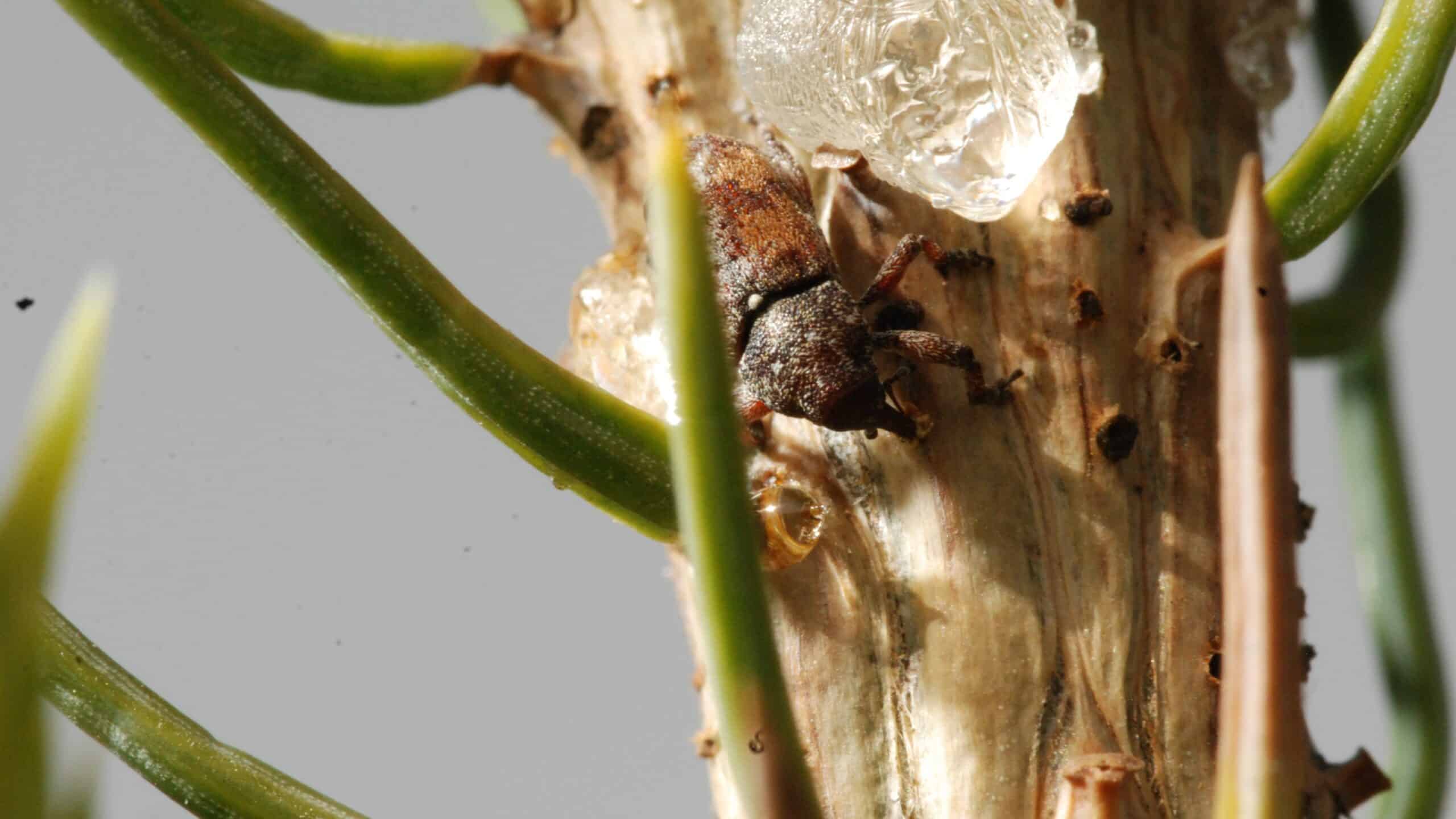Study Reveals How a Tall Spruce Develops Defense Against Hungry Weevils

For Immediate Release
A study led by a North Carolina State University researcher identified genes involved in development of stone cells – rigid cells that can block a nibbling insect from eating budding branches of the Sitka spruce evergreen tree. The insect’s attack has stunted the growth of these forest giants.
The new findings could help researchers breed genetically improved Sitka spruce trees resistant to the spruce weevil (Pissodes strobi).
“We wanted to learn about the genetic basis for natural pest resistance that certain Sitka spruce trees have evolved to prevent insects from feeding on the plant,” said Justin Whitehill, assistant professor of Christmas tree genetics at NC State and first author of the study. Whitehill started the study as a postdoctoral researcher at the University of British Columbia, where the laboratory experiments were completed.
“The trait we studied in Sitka spruce is a physical defense known as stone cells, which are found in almost all plant species,” said Whitehill. “They are responsible for the gritty texture you feel when eating a pear. Stone cell development is very complex, involving thousands of genes. We identified some of the genetics involved in the key early steps for these cells’ development.”
The Sitka spruce is a large conifer tree that grows on the West Coast from California to Alaska. While the tree has been replaced with other species for timber products in North America because of susceptibility to the weevil, it is still a prominent timber species in Europe. Many trees grown on the West Coast for forestry products were derived from a fast-growing population that grew on an island and were never exposed to the weevil, which left them extremely susceptible, Whitehill said.
However, a group of resistant Sitka spruce trees was discovered in Canada that develop stone cells, a rigid cell type that only grow in less than an inch of the top of budding branches – the same area where the weevil feeds.
“The stone cells slow down the progression of the insect and give time for the resin found in the trees’ bark to coat the insect and make it too sticky to feed more,” Whitehill said. “Stone cells block these insects as they try to eat through the plant and slow them down enough to prevent them from causing significant damage to the tree.”
In their recent study, researchers found nearly 1,300 genes that were expressed at higher levels in stone cells. They also identified a key gene that functions as a “master switch” and is responsible for activating thousands of other genes known to control the development of thick-walled cells in other plants.
“This paper lays out a roadmap of the genes involved in stone-cell development,” Whitehill said. “We’re showing it’s strongly controlled by genetics involved in secondary cell walls.”
Key to the researchers’ study was a microdissection tool that uses a laser to cut extremely tiny slices of tissue into thin sections. Researchers were able to cut tiny sections from the buds of actively growing Sitka spruce branches to study genes expressed specifically in stone cells during their formation.
Whitehill said he has received funding to bring an updated version of this technology to NC State. Now, researchers here are using laser microdissection to study genes in the Fraser fir tree – a leading Christmas tree in the United States grown in western North Carolina. They are using this technology to investigate important features that could boost the viability, fragrance and pest resilience of the Fraser fir, a tree with a genome size five times bigger than humans.
“We’re using this approach now to look for genes involved in resistance to pathogens and pests, and to understand complex ecological interactions at the genetic level,” Whitehill said.
The paper, “Transcriptome features of stone cell development in weevil-resistant and susceptible Sitka spruce,” was published online in New Phytologist. Co-authors included Macaire M.S. Yuen, Angela Chiang (current NC State Christmas Tree Genetics program lab manager and research associate), Carol E. Ritland and Jörg Bohlmann. The work was supported by funds from the Natural Sciences and Engineering Research Council of Canada (NSERC) Discovery Grants Program, and from the Genome Canada, Genome British Columbia, and Genome Quebec SpruceUp Project (243FOR).
-oleniacz-
Note to Editors: The study abstract follows.
Transcriptome features of stone cell development in weevil-resistant and susceptible Sitka spruce
Authors: Justin G. A. Whitehill, Macaire M. S. Yuen, Angela Chiang, Carol E. Ritland, and Jörg Bohlmann
Published: July 4, 2023, New Phytologist
DOI: 10.1111/nph.19103
Abstract: SUMMARY
- Stone cells are a specialized, highly lignified cell type found in both angiosperms and gymnosperms. In conifers, abundance of stone cells in the cortex provides a robust constitutive physical defense against stem feeding insects. Stone cells are a major insect-resistance trait in Sitka spruce (Picea sitchensis), occurring in dense clusters in apical shoots of trees resistant (R) to spruce weevil (Pissodes strobi) but being rare in susceptible (S) trees.
- To learn more about molecular mechanisms of stone cell formation in conifers, we used laser microdissection and RNA sequencing to develop cell-type-specific transcriptomes of developing stone cells from R and S trees. Using light, immunohistochemical, and fluorescence microscopy, we also visualized the deposition of cellulose, xylan, and lignin associated with stone cell development.
- A total of 1293 genes were differentially expressed at higher levels in developing stone cells relative to cortical parenchyma. Genes with potential roles in stone cell secondary cell wall formation (SCW) were identified and their expression evaluated over a time course of stone cell formation in R and S trees.
- The expression of several transcriptional regulators was associated with stone cell formation, including a NAC family transcription factor and several genes annotated as MYB transcription factors with known roles in SCW formation.
- Categories:


